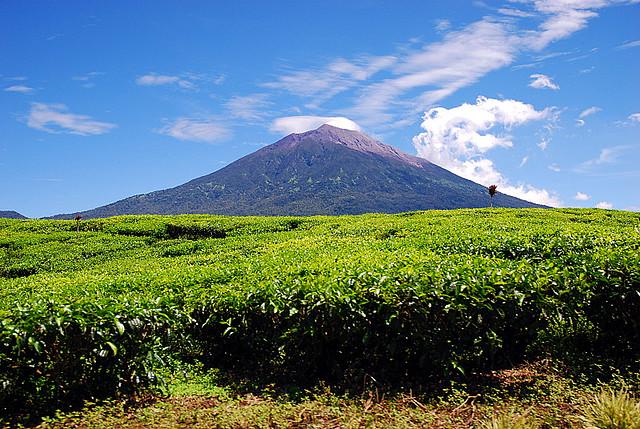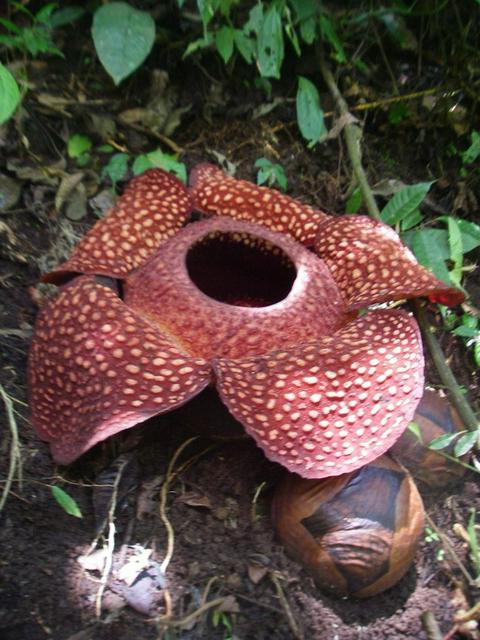Kerinci Seblat National Park is an Indonesian National Park in Sumatra, spanning four provinces.
 One of the largest national parks in Indonesia, Kerinci Seblat protects almost of tropical rain forests in central western Sumatra running down the Barisan mountain range and its foothills and covering parts of four provinces. Terrains varies from lowland forests up to the peak of mighty Mt Kerinci at 3,805 m.
One of the largest national parks in Indonesia, Kerinci Seblat protects almost of tropical rain forests in central western Sumatra running down the Barisan mountain range and its foothills and covering parts of four provinces. Terrains varies from lowland forests up to the peak of mighty Mt Kerinci at 3,805 m.
The national park is a UNESCO World Heritage Site as part of the Rainforest Heritage of Sumatra and one of the most important tiger reserves in the world.
The national park was formed from a collection of watershed protection forests (hutan lindung) and nature reserves and was established in 1982 although its boundaries were not legally formalised until the mid 1990s.
The park is dominated by the Barisan mountains. Scenery in many areas is very spectacular with active and dormant volcanoes including Mount Kerinci, at 3805m the highest mountain in Sumatra and Indonesia's highest active volcano. The national park forests protect the headwaters of some of Sumatra's most important rivers which flow from springs and peat swamps like Ladeh Panjang (Kerinci district) and Danau Kebut (Merangin district) high in the mountains, as well as many lakes and wetlands.
The Great Sumatra Fault runs through the centre of the national park and forms the densely populated Kerinci valley, which lies in the middle of and is surrounded by national park forests.
Kerinci Seblat is most famous amongst bird-watchers as the best place to see most of the highland Sumatran endemic bird species including the Schneider's Pitta, Salvadore's pheasant and Sumatran Cochoa, all presumed extinct for much of the 20th century before being rediscovered here. More than 375 species of bird have been recorded to date.
This is also the most important location in Sumatra for wild Sumatran Tiger and one of the 12 most important tiger reserves anywhere in the world although seeing wild tigers is unusual due both to the dense forest and the animals' shy nature. Other fauna includes elephants (best seen in national park forests in Bengkulu), clouded leopards, tapirs, sun bears and at least seven species of primate.
Forest edge farmers continue to report occasional sightings of the mysterious orang pendek, a large, bipedal cryptozoological primate resembling an orangutan (which are not recorded in Kerinci Seblat).
The national park also houses the biggest and the tallest flowers in the world, the monstrous, flesh red flower of the parasite Rafflesia arnoldi which can grow up to a metre in diameter, and is best searched for in the Bengkulu area of the park - ask for flowering information in Curup. In the southern part of Kerinci district hope to see the slightly smaller Rafflesia hasselti which is a vivid dark red in colour. The huge Amorphophallus titanum and Amorphophallus gigas are also present and can grow up to 4 metres in height. A remarkable flower at higher altitudes on Mt Kerinci and Mt Tujuh is the Javanese edelweiss Anaphalis javanica, which only grows on volcanoes. This shrub can reach more than two metres in height and is colored white-green because of its small hairs; the flowers are yellow with white. Numerous orchids are also found, most often flowering at the beginning of the rainy season in late September or October.
Rainfall is heaviest between October-December and from February-April while May-August is mainly dry but with some occasional rains, there are no major variations in seasonal temperature. Photographers may wish to avoid the period July-August as these dry months are often hazy. Because much of the park is above 700m in altitude, evenings and nights tend to be cool while in the high mountains temperatures may occasionally drop as low as 5C at night and so trekkers should be prepared for cool evenings
You should bring a photocopy of your passport, to be given to the authorities to process your national park entry permit. Visitors planning to climb Mt Kerinci can get a photocopy made at the village of Kersik Tuo at the foot of the mountain. Photocopies of your passport and the visa section are also useful if staying in a village as your homestay must report visitors to the head of the village or the local police post.
The price for entry to the national park as of February 2012 is Rp 20,000 per person. Buy tickets at the national park headquarters in Sungaipenuh, Kerinci, at Kersiktua, at Curup (near Bengkulu) or in Bangko if you are planning to visit Renah Kemumu or the national park forests in Merangin district.

- Tea plantations, at Mt Kerinci. Before climbing the mountains, the tea plantations are vastly spreading across the side of the roads. You can tour after getting permission from the locals.
- Hot springs, at Mt Kunyit, Talang Kemuning, Kerinci, Semerup, Kerinci or in Renah Kemumu, Merangin district.. Traditional dance ceremonies and maybe a Tiger calling ceremony by a Kerinci shaman.
- Lake Kerinci. The view of the Kerinci valley and Lake Kerinci from Bukit Kayangan (above Sungaipenuh, fantastic forest scenery at Bukit Tapan and Muara Imat village
- Elephant sanctuary, at Seblat, Bengkulu to the west of the national park. Ask permission from KSDA Bengkulu first.
- Remote, rarely visited traditional forest-edge villages in Jangkat and Sungai Tenang and Muara Siau areas of Merangin district.
- Megaliths in the Kerinci valley and at remote and rarely visited Renah Kemumu village in Merangin district.
- Lake Gunung Tujuh. South East Asia's highest crater lake and still surrounded by pristine forests and the marshlands of Lake Bentau.
- Rafflesia Arnoldii. The infamous Rafflesia Arnoldii can be found on the Bengkulu side of the park. Don't let the pretty appearance fool you because this is actually a corpse flower. But it only spews the horrid smell once in a while.
Tea plantations, at Mt Kerinci. Before climbing the mountains, the tea plantations are vastly spreading across the side of the roads. You can tour after getting permission from the locals.
Hot springs, at Mt Kunyit, Talang Kemuning, Kerinci, Semerup, Kerinci or in Renah Kemumu, Merangin district.. Traditional dance ceremonies and maybe a Tiger calling ceremony by a Kerinci shaman.
Lake Kerinci. The view of the Kerinci valley and Lake Kerinci from Bukit Kayangan (above Sungaipenuh, fantastic forest scenery at Bukit Tapan and Muara Imat village
Elephant sanctuary, at Seblat, Bengkulu to the west of the national park. Ask permission from KSDA Bengkulu first.
Remote, rarely visited traditional forest-edge villages in Jangkat and Sungai Tenang and Muara Siau areas of Merangin district.
Megaliths in the Kerinci valley and at remote and rarely visited Renah Kemumu village in Merangin district.
Lake Gunung Tujuh. South East Asia's highest crater lake and still surrounded by pristine forests and the marshlands of Lake Bentau.
Rafflesia Arnoldii. The infamous Rafflesia Arnoldii can be found on the Bengkulu side of the park. Don't let the pretty appearance fool you because this is actually a corpse flower. But it only spews the horrid smell once in a while.
- Mount Kerinci. The highest volcano in Indonesia at above sea level. Climbing it takes at least two days and one night including the descent. There are three shelters along the path for camping.
The park offers superb trekking and climbing opportunities for both novices and the more experienced as well as bird and wildlife watching whether just going for a walk for a day or a week-long jungle expedition.
If staying in Sungaipenuh, ask the National Park office or your hotel to help you rent a car (motor bikes not advised!) for a Night Safari through the forests of Bukit Tapan: the road passes through dense forests and a night drive (leave about 22:00, return at 01:00-02:00) gives a chance to experience tropical forest at night — and the chance to see some of the inhabitants (Sumatran tigers, Asiatic golden cat, sunbears, tapir, civet cats and rare serow antelopes are among the animals that have been spotted)
Go bird watching or just enjoy fantastic scenery from a dugout canoe in beautiful Lake Bentau, a stunning marshland area at the foot of Mt Tujuh. The Kerinci Bird Watching Club are now starting to offer specialist bird watching trips for visiting 'twitchers' http://kerincibirdclub.wordpress.com
Trek (two days, one night) from Talang Kemuning village (two hours from Sungaipenuh) to forests of Mt Kunyit (south of the Kerinci valley) to see sulphur pits and hot springs and pitcher plants or from Renah Kayu Embun (Sungaipenuh) climb to the peak of Mt Raya for fantastic views and rare flora such as the Kayu Embun tree and pitcher plants, Kerinci rabbits and yes, the chance of a possible Sumatran tiger encounter.
More adventurous forest treks - the forest trail west from Lempur in the south of Kerinci district to Sungai Ipuh village in Mukomuko district of Bengkulu - allow five days though the locals do the trip in 3 days (you will need special permission from park headquarters); Lempur to Rantau Kermas via the ancient enclave village of Renah Kemumu (4 days - megaliths and hot springs and stunning scenery) or stay in forest villages in Muara Siau, Merangin district like Durian Rambun or Lubuk Bira.
Tiger watching- unlike India it is difficult to see wild Sumatran tigers even though there may be as many as 200 tigers in and around Kerinci Seblat but national park officers will advise on areas where tigers are usually present and suggest experienced guides. And yes, people do see tigers.
The Muara Imat-Birun area on the Kerinci-Merangin district borders is one of the best places to hope to see wild tigers or at least tiger signs as well as Rafflesia and Amorphophallus, rare orchids and good birdwatching. Ask at the national park offices.
Mount Kerinci. The highest volcano in Indonesia at above sea level. Climbing it takes at least two days and one night including the descent. There are three shelters along the path for camping.
The national park office has a range of t-shirts designed by young national park officers while exploring village and small town markets offers the chance to buy simple local handicrafts and woven baskets still routinely used by villagers. Never buy wildlife products or wild plants.
Food in the restaurants in the small towns around the national park is mainly Padang rice and a variety of meat, fish and vegetable dishes liberally spiced with chilli. If you do not like spicy food, ask for 'tidak pedas'.
In Kerinci district look for restaurants offering 'dendeng batokok' - a grilled, finely sliced, smoked steak.
